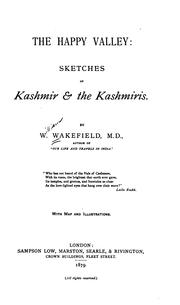On glancing at the map of the great continent of Asia, we find in the north-west of Hindustan that division of our Empire in the East termed the Punjab, "the country of the five rivers;" an extensive territory watered by the Indus and its great affluents--the Jhelam, Chenab, Ravi, Beas, and Sutlej--the widest expanse of the great plains of India, and a British possession since the year 1849, which saw the final downfall of the Sikh power. p 1-2
Check nearby libraries
Buy this book

A description of life, travel and commerce in Kashmir in 1875.
Check nearby libraries
Buy this book

Previews available in: English
Subjects
Description and travel, TravelPlaces
Jammu and Kashmir (India)Showing 2 featured editions. View all 2 editions?
| Edition | Availability |
|---|---|
|
1
Happy Valley: Sketches of Kashmir and the Kashmiris
December 1, 1996, Laurier Books Ltd. /AES
Hardcover
8120611004 9788120611009
|
bbbb
Libraries near you:
WorldCat
|
|
2
The happy valley: sketches of Kashmir & the Kashmiris.
1879, S. Low, Marston, Searle, & Rivington
in English
|
aaaa
Libraries near you:
WorldCat
|
Book Details
Published in
London
Edition Notes
Reprinted in 1975 under title: History of Kashmir and the Kashmiris.
Map wanting.
Classifications
The Physical Object
ID Numbers
Excerpts
added by Katharine Hadow.
In the Ayin-i-Akbari mention is made of four distinct classes of shawls. First come those of remarkable lightness and softness, usually self-coloured, and made from wool undyed. The second variety were woven of wool in the natural colours--white, black, or grey, and were probably of plaid pattern, like the shepherd's plaid in Scotland. The third were called gold-leaved, probably from being embroidered with that material. The fourth were long pieces used to enwrap the whole body, or to fashion into divers articles of attire.
Page 143,
added by Katharine Hadow.
All shawls are made from what is termed 'pushmeena,' which is the short undercoat or fleece of the Kashmir goat, a variety of that animal remarkable for very long, fine, and silky hair; but whose appellation is evidently a misnomer, since it is not so generally found in the country whence it derives its name as in Western Tibet, where immense herds are reared upon the mountains.
Page 143-44,
added by Katharine Hadow.
The manufacture of shawls being under government control, a duty is imposed on every pair made; heavy penalties being also inflicted if a genuine article is not produced. The manufacture is carried on in the city, in single houses, or in factories, and the weavers, or 'wabster bodies,' as they would be termed at Paisley, are easily distinguishable from the mass of the population by their stunted frame and sickly look, the usual characteristics of those that follow this occupation in every other part of the world.
Page 145-46,
added by Katharine Hadow.
[M]any of the farmers and their families occupy their spare time in weaving; and I well remember our astonishment, when taking refuge from a storm at a farm-house...to find ourselves on opening a door which presumedly led to the cow-house or stables, in a room dirty and close enough to poison a dog, but the atmosphere of which was evidently of indifference to the family of our host, who were all, from the aged grandsire down to the youngest-born, busily employed at a roughly-made loom in weaving a pair of shawls, which were estimated to be of the value of 3,000 rupees each. The worthy agriculturist told us further that they would not be completed under three years, but that the price would amply repay him. This is certainly would, even if he got considerably less than he stated, the most expert of weavers rarely earning more than a small rupee a day, but which, so far as the expenses of living are concerned, is fully equal to ten shillings per diem in England.
Page 146,
added by Katharine Hadow.
Community Reviews (0)
Feedback?| May 15, 2022 | Edited by ImportBot | import existing book |
| August 12, 2020 | Edited by MARC Bot | remove fake subjects |
| April 28, 2016 | Edited by Katharine Hadow | overview and excerpts |
| May 6, 2010 | Edited by EdwardBot | add Accessible book tag |
| December 10, 2009 | Created by WorkBot | add works page |











